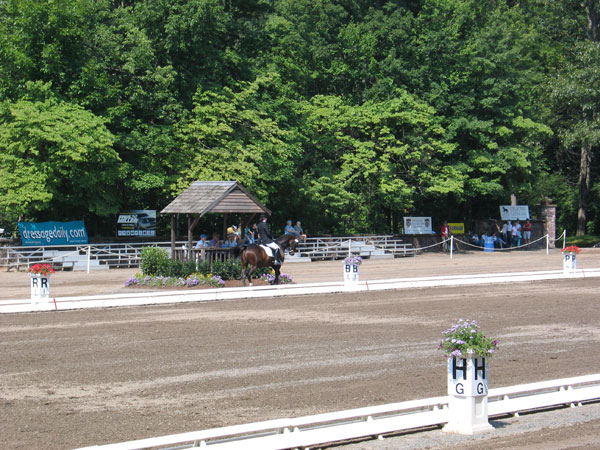Q: I have noticed a difference in scores from a regulated show versus a schooling show. Is this a common thing? If there is a difference, why? Could you also clarify the number scores? What goes into determining those numbers? How do I turn 7s into 8s?
Name withheld by request

A: I smiled as I read your questions regarding horse shows, judging and score clarification. As both a dressage trainer and judge, I, too, have been to many schooling shows where the scoring seemed more generous than at a U.S. Equestrian Federation (USEF)-recognized show. I, for one, am truly grateful and have come to expect it, as schooling shows are typically our grass-roots introduction shows and need to be fun, safe, educational and, most importantly, encouraging situations for everyone. Most of us use schooling shows to gain mileage and experience, to correct show-ring problems we may have gotten into and to have a positive, relaxed atmosphere to bring beginning riders and/or green horses into a show-ring setting. Riders and trainers also use schooling shows to prepare horses and riders before moving up a level to make sure they are prepared before adding the extra pressure of a USEF-recognized show.
A judge at a schooling show is typically encouraged and expected to be more instructive to the competitors due to the sheer nature of a schooling show. The atmosphere is usually much more relaxed, and the time frame more flexible for feedback and corrections. The judges are less limited in their comments and can often feel free to give a mini riding lesson at the bottom of the test sheet or even by mouth at the end of the ride. This is not allowed at rated (recognized) shows. A recognized show has a strict format, time schedule and rule book to follow, which does not allow judges to give riding lessons or converse freely with the competitors around the arena as they may at a schooling show.
A USEF-recognized show is required to hire judges who have been through rigorous training and courses to get their status to be able to judge rated shows. It is an intense process to not only become a rated judge but also to continue one’s education and maintain one’s license. Schooling shows find judges from the same roster of judges but often employ “Learner” judges. Learner judges are highly educated but may not yet have the years of experience sitting in the judge’s box. Schooling shows are a great way to give them more mileage. All judges, whether they are at a schooling show or big CDIs, try to be as encouraging and helpful as possible with their scores and comments.
To help understand why your scores are what they are, let’s look at how a judge is required to judge. Each specific movement on your test sheet gets a number and a comment (a comment is not required for a 7 or higher). In each box of your test, the judge is evaluating the basics or the qualities of the training scale: Is the rhythm (gait) pure and clear? Is the horse accepting the contact and to what degree at what level? Does the horse have impulsion? How is his ability to connect, straighten and collect? After that is assessed in a matter of a millisecond for most judges, they look at the quality of the actual movement being performed (the criteria). Does the shoulder-in have enough bend and angle? Does the horse stand balanced and immobile at the halt before he performs the rein-back?
And lastly, the judges quickly see if the atmosphere surrounding the movement was a bonus or not. Were the corners leading into the shoulder-in balanced and smooth? Was it executed at the correct letters? Did the rein-back have the right amount of steps? We call these “modifiers.” So, basics + criteria + modifiers = score.
This is how judges arrive at every single score they give. Most seasoned judges can take one glimpse at a horse and arrive at a basic score for the training scale and overall quality of the gaits almost immediately. Then they watch the movement being performed and, bingo, you have your score:
10 excellent
9 very good
8 good
7 fairly good
6 satisfactory
5 marginal
4 insufficient
3 fairly bad
2 bad
1 very bad
0 not performed
There are always a handful of horses who can be trickier to decide on. These are typically horses who have an extravagant way of moving their front legs but often their hind legs don’t match up. In my experience, such horses tend to cause the most discrepancy between judges’ scores, especially from the judges sitting on the side at E or B compared to the judge at C. Depending on where you sit, the perspective can be different.
As a competitor, it is most helpful to read your USEF Rule Book. The section on dressage is helpful information that spells out what is expected from the horse and rider in the dressage tests at each level. It is not just rules but very detailed descriptions of each movement and the criteria that should be met to make a sufficient or better score.
I hope this helps you understand judging better. Horse-showing is a wonderful way to get fresh ideas and opinions from various judges. You may not always like what you get, but more than likely, you will always leave with a great learning experience.

Tami Batts is a U.S. Dressage Federation (USDF) gold medalist and a U.S. Equestrian Federation (USEF) “S”dressage judge. She competes her stallion Ranko at Intermediaire and trains out of her family’s Fellowship Farm in Greensboro, North Carolina (fellowshipfarm.net).












